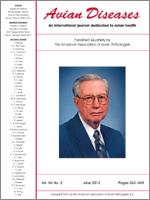Rodents play a major role in the transmission and maintenance of Salmonella contamination cycles in poultry facilities. However, very limited field data are available regarding the transmission routes, infection cycle, and shedding patterns of Salmonella by naturally infected wild rodents from commercial layer farms. In this study, a total of 128 resident wild roof rats (Rattus rattus) were captured from a Salmonella-contaminated layer facility. All roof rats were divided into 51 laboratory cages, and weekly monitoring of Salmonella fecal shedding patterns was conducted for 53 wk. Seven roof rats from cages that were observed to frequently shed Salmonella were isolated in individual cages, and daily Salmonella monitoring was performed for 35 days. At the end of monitoring, each roof rat was euthanatized, and isolation of Salmonella from different organs was performed. Results of weekly monitoring of Salmonella showed that 21 of 51 cages (41.2%) were positive for Salmonella Infantis, while two cages (3.92%) were positive for Salmonella Enteritidis. Moreover, 11 cages were positive for Salmonella for at least two sampling weeks. Isolation of Salmonella from fecal droppings was mainly observed during the first 12 wk of captivity. The longest interval between two Salmonella-positive fecal dropping was 24 wk. In the daily Salmonella monitoring, only Salmonella Infantis was isolated from fecal droppings, in which the highest number of Salmonella Infantis organisms per fecal dropping was at 1 × 108 colony-forming units (cfu), while the lowest measured quantity was 1 × 103 cfu. It was noted that the frequency of Salmonella shedding in fecal droppings appeared to have a linear correlation (r = 0.85) with the number of Salmonella organisms (cfu) per fecal pellet (P < 0.05). Moreover, pulsed-field gel electrophoresis analysis of Salmonella Infantis isolates revealed a single identical pulsed-field pattern. Salmonella Enteritidis isolates from fecal droppings and internal organs also generated a single identical pulsed-field pattern. Interestingly, Salmonella Infantis was not isolated from any of the organs examined, while Salmonella Enteritidis was isolated from the spleen and liver of one roof rat. These results may indicate that wild roof rats could persistently carry Salmonella and contaminate commercial poultry facilities through intermittent fecal shedding. Moreover, Salmonella Enteritidis in wild roof rats appears to be more of a systemic infection, in which isolation is most likely to occur in internal organs, whereas Salmonella Infantis is more likely an enteric type of infection, in which isolation is most likely to occur in the intestinal contents. It is very plausible that layer chickens could become infected with Salmonella through ingestion of Salmonella-positive fecal droppings or feeds contaminated with these fecal droppings from infected resident roof rats. This is
How to translate text using browser tools
1 June 2012
Transmission and Shedding Patterns of Salmonella in Naturally Infected Captive Wild Roof Rats (Rattus rattus) from a Salmonella-Contaminated Layer Farm
Dennis V. Umali,
Randy Rhon Simoun P. Lapuz,
Terumasa Suzuki,
Kazutoshi Shirota,
Hiromitsu Katoh
ACCESS THE FULL ARTICLE

Avian Diseases
Vol. 56 • No. 2
June 2012
Vol. 56 • No. 2
June 2012
chicken
commercial layer farm
fecal shedding patterns
poultry
pulsed-field gel electrophoresis
rodents
roof rats




